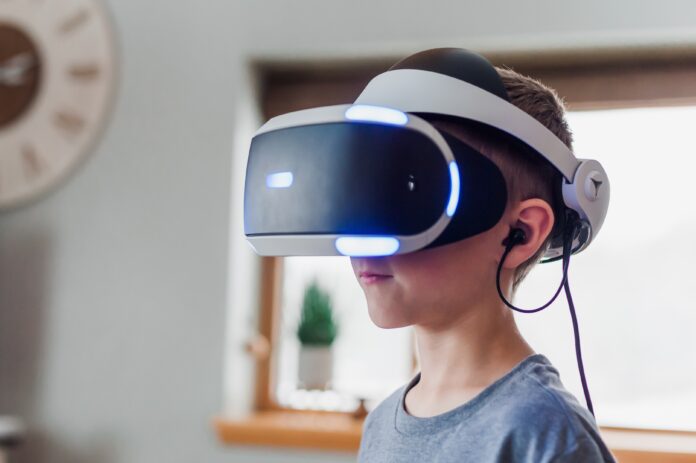WebXR, an emerging technology that blends the power of the web with the immersive capabilities of virtual and augmented reality, is revolutionizing the way we interact with digital content. In a rapidly evolving digital landscape, WebXR opens up a whole new realm of possibilities, enabling users to experience virtual worlds, engage with augmented reality overlays, and collaborate in mixed reality environments—all through a web browser. As an extension of the web, WebXR aims to make immersive experiences more accessible, portable, and inclusive, transforming the way we learn, communicate, and interact in the digital realm.
WebXR brings together the concepts of virtual reality (VR), augmented reality (AR), and mixed reality (MR) and provides a standardized framework for creating immersive experiences that can be accessed through compatible web browsers across multiple devices. Unlike traditional VR and AR applications that often require the installation of specific software or dedicated apps, WebXR leverages the power of the web to deliver interactive and immersive content seamlessly.
At its core, WebXR is built on established web technologies such as HTML, CSS, and JavaScript, making it familiar to web developers and accessible to a broader audience. It leverages the capabilities of modern devices, including smartphones, tablets, PCs, and virtual reality headsets, to deliver rich and interactive experiences that can be easily accessed and shared.
With WebXR, users can dive into virtual worlds and explore 3D environments, whether it’s visiting a historical site, touring a museum, or experiencing a simulated training scenario. By combining the visual and auditory elements of virtual reality, users can be transported to new places and engage with digital content in a highly immersive and interactive manner.
Furthermore, WebXR extends its reach to augmented reality, overlaying virtual content onto the real world. Through the camera of a device, users can experience augmented reality applications directly in their physical surroundings. This opens up a wide range of possibilities, from interactive educational experiences to practical applications in fields such as architecture, interior design, and retail.
WebXR also enables mixed reality experiences, where virtual and real-world elements coexist and interact with each other. This blend of virtual and physical environments creates unique opportunities for collaboration, training, and interactive storytelling. Users can collaborate in real-time, manipulate virtual objects in the real world, or engage in shared virtual experiences with others, regardless of their physical location.
One of the key strengths of WebXR is its accessibility. By leveraging web technologies, it eliminates the need for users to download and install specific applications or software. All that is required is a compatible web browser, and users can access a wide range of immersive experiences instantly. This accessibility not only benefits end-users but also opens up new opportunities for developers and content creators to reach a broader audience without the barriers of platform-specific software.
Moreover, WebXR promotes inclusivity by removing the hardware limitations that often accompany traditional virtual and augmented reality experiences. While dedicated VR headsets and AR devices offer immersive experiences, they can be costly and require specific hardware configurations. WebXR, on the other hand, allows users to access immersive content using a range of devices, from high-end virtual reality headsets to smartphones and tablets. This inclusivity ensures that more people can engage with and benefit from immersive experiences, regardless of their access to specialized hardware.
In terms of development, WebXR provides a standardized framework that simplifies the creation of immersive experiences. Developers can leverage existing web development skills and tools to build WebXR applications, making it easier to create and iterate on content. This streamlined development process encourages innovation, collaboration, and rapid iteration, leading to the growth of a vibrant ecosystem of WebXR experiences.
The potential applications of WebXR are vast and diverse. In the realm of education, WebXR can transform the way students learn by providing immersive and interactive experiences that enhance comprehension and engagement. From virtual field trips to interactive science simulations, WebXR has the potential to make learning more dynamic and accessible.
In the realm of e-commerce, WebXR can revolutionize the way customers shop for products by allowing them to visualize and interact with virtual representations of items before making a purchase. This immersive shopping experience can provide a better understanding of the product, increase customer satisfaction, and reduce the need for returns.
WebXR also has significant implications for social interactions and collaboration. By enabling shared virtual experiences, users can connect and interact with others in virtual spaces, regardless of their physical location. This opens up new avenues for remote collaboration, virtual conferences, and social interactions, fostering a sense of presence and connection in the digital world.
In conclusion, WebXR represents a transformative technology that combines the power of the web with the immersive capabilities of virtual and augmented reality. By leveraging web technologies, WebXR makes immersive experiences more accessible, portable, and inclusive. Whether exploring virtual worlds, engaging with augmented reality overlays, or collaborating in mixed reality environments, WebXR opens up a whole new realm of possibilities for learning, communication, and interaction. As the technology continues to evolve and gain wider adoption, we can expect to see an increasing number of immersive web experiences that enrich our digital lives and reshape the way we interact with digital content.
Immersive Experiences:
WebXR allows users to engage in immersive experiences, including virtual reality, augmented reality, and mixed reality, through compatible web browsers.
Cross-Device Compatibility:
WebXR is designed to work seamlessly across various devices, including smartphones, tablets, PCs, and virtual reality headsets, making it accessible to a wide range of users.
Web-Based Development:
WebXR leverages familiar web technologies such as HTML, CSS, and JavaScript, enabling developers to create immersive experiences using their existing skills and tools.
Accessibility:
With WebXR, users can access immersive content directly through their web browsers without the need to install specific applications or software, promoting greater accessibility and ease of use.
Inclusivity:
WebXR supports a range of devices, from high-end virtual reality headsets to smartphones, ensuring that more people can engage with immersive experiences regardless of their access to specialized hardware.
Standardized Framework:
WebXR provides a standardized framework for developing immersive experiences, simplifying the development process and fostering innovation in the creation of web-based XR content.
Interactive 3D Content:
WebXR enables the creation and rendering of interactive 3D content, allowing users to explore and interact with virtual environments, objects, and characters.
Real-Time Collaboration:
WebXR facilitates real-time collaboration in virtual and mixed reality environments, enabling users to collaborate, communicate, and interact with others remotely, regardless of their physical location.
Augmented Reality Overlays:
WebXR supports the overlaying of virtual content onto the real world through the camera of a device, enabling users to experience augmented reality applications directly within their physical surroundings.
Extensibility and Integration:
WebXR is designed to be extensible, allowing developers to integrate additional technologies, APIs, and frameworks to enhance and expand the capabilities of immersive web experiences.
WebXR, the amalgamation of web technologies and extended reality (XR), represents a groundbreaking advancement in the world of digital experiences. This convergence of the web and immersive technologies is reshaping how we interact with digital content and opening up new frontiers for creativity, communication, and exploration.
With WebXR, the boundaries between the physical and virtual worlds blur, creating a seamless and fluid experience where users can transcend the limitations of traditional interfaces and dive into immersive digital realms. It fosters a sense of presence and engagement by leveraging the power of spatial computing, 3D graphics, and real-time interactions.
One of the most exciting aspects of WebXR is its potential to revolutionize storytelling and narrative experiences. Traditional storytelling often relies on static mediums like text, images, or videos, limiting the depth of engagement. However, with WebXR, storytellers can craft dynamic and interactive narratives that transport users into the heart of the story. Imagine being able to step into the shoes of a protagonist, explore immersive environments, and actively participate in shaping the outcome of the narrative. WebXR unlocks a new dimension of storytelling that captivates audiences and immerses them in captivating worlds.
Beyond entertainment and storytelling, WebXR has far-reaching implications for education and training. It has the potential to revolutionize how we learn and acquire new skills by providing immersive and interactive educational experiences. For instance, students can embark on virtual field trips to explore historical landmarks, dive into realistic simulations to understand complex scientific concepts, or practice real-life scenarios in a safe and controlled environment. WebXR empowers educators to create engaging and experiential learning environments that enhance retention, engagement, and understanding.
WebXR also holds immense potential for industries such as architecture, design, and engineering. Professionals in these fields can leverage the power of immersive technologies to visualize and manipulate 3D models in real-time, facilitating better collaboration, feedback, and design iterations. Architects can immerse themselves in virtual walkthroughs of their designs, gaining a deeper understanding of spatial relationships and making informed decisions. Interior designers can create virtual mock-ups of spaces, allowing clients to explore and experience the design before it is realized physically. WebXR empowers professionals to push the boundaries of creativity and innovation, transforming the way they conceptualize, communicate, and bring ideas to life.
The social dimension of WebXR is equally compelling. It enables shared experiences and social interactions in virtual environments, bridging the gap between physical distance and fostering connections in the digital realm. Friends and family members can gather in virtual spaces to play games, watch movies, or simply hang out, regardless of their geographical locations. This immersive social interaction adds a new layer of depth and intimacy to online connections, creating a sense of togetherness even when physically apart.
Furthermore, WebXR has the potential to democratize access to XR experiences. Traditional virtual reality and augmented reality setups often require specialized hardware and dedicated applications, limiting access to a select few. However, with WebXR, anyone with a compatible device and a web browser can access immersive experiences without the need for expensive equipment or software installations. This accessibility has the power to bridge the digital divide and bring XR to a wider audience, unlocking new opportunities for creativity, learning, and entertainment.
As WebXR continues to evolve, it is expected to witness advancements in areas such as haptic feedback, spatial audio, and real-time collaboration. Haptic feedback technologies can simulate the sense of touch, allowing users to feel and interact with virtual objects, further enhancing the immersive experience. Spatial audio enhances the realism of virtual environments by providing accurate soundscapes that respond to the user’s position and movement. Real-time collaboration capabilities enable users to work together in shared virtual spaces, facilitating teamwork, communication, and co-creation.
In conclusion, WebXR represents a paradigm shift in the way we engage with digital content. By combining the power of the web with immersive technologies, it enables the creation of captivating, interactive, and accessible experiences that transcend traditional interfaces. Whether in the realms of storytelling, education, design, or social interaction, WebXR unlocks new possibilities for creativity, collaboration, and exploration. As this transformative technology continues to advance, we can expect to witness a proliferation of immersive web experiences that redefine how we perceive, interact with, and connect to the digital world.














